Introduction
It was difficult for me to come up with the right name for this article. I could have called it “Death Valley and Yosemite in Winter”, or “The Beauty of Elegant Tools”, or “How to Photograph with Non Photographer Friends”.
In the end, the title derived from the tremendous joy I experience when shooting with a Technical camera.

Yosemite Winter Vista
CAMBO WRS 1600 with Rodenstock 90 mm APO Digaron lens
Hard To Explain
Some things are practically impossible to explain with words. To understand them, one has to experience them.
For instance, one cannot explain to someone who has never skied, exactly what it feels like to ski. One cannot explain to someone who has never driven a car, exactly what it feels like to drive a car. Similarly, one cannot explain with words what it is like to use a technical camera. There is a rhythm to it and there is a flow to it that is completely different from using an SLR. It is totally unique, it is amazingly beautiful and it must be experienced in order to appreciate it.
There is no question in my mind that the elegance of the tool, combined with its capabilities and the unique flow and rhythm mentioned above significantly affects the final image.
Note: If you are not familiar with view camera or technical camera movements, I suggest you read this page. For a quick look at some of the modern view and technical cameras available, click here.
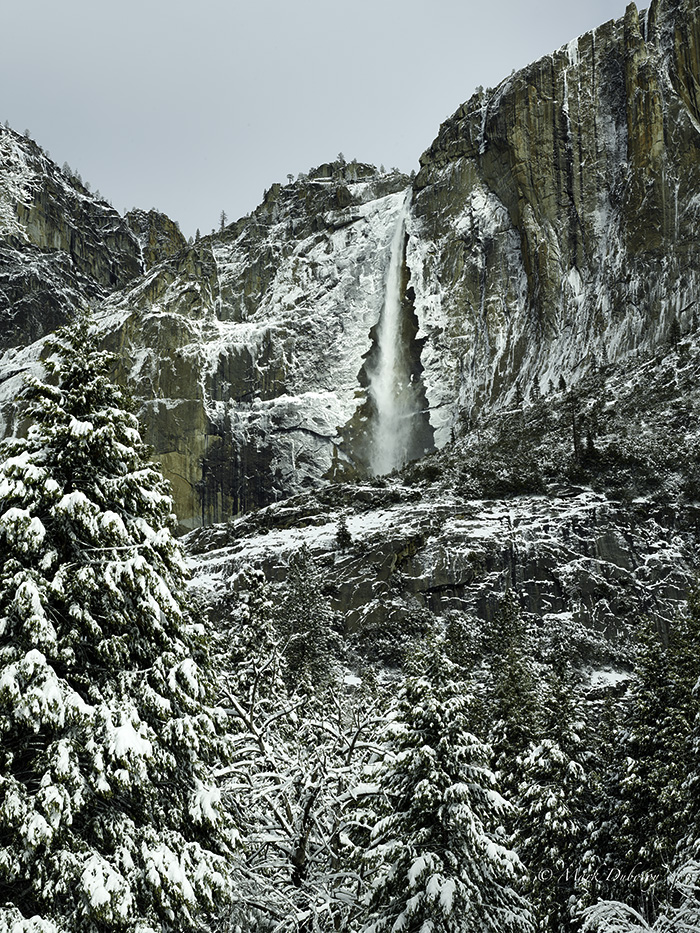
Frozen Waterfall, Yosemite
CAMBO WRS 1600 with 90 mm Rodenstock APO Digaron lens
The Story Behind The Images
I have some very dear friends that are California natives. Amazingly, they had never been to Yosemite or Death Valley.
We scheduled a trip to these two wonderful locations. I picked early March as a great time to do it with the expectation that by then the weather would be warm with a few remnants of winter in the higher elevations only.
Little did I know at the time I set up the trip that this winter would be the wettest and the most snowy California winter in recent memory. Compared to the way it normally looks, Death Valley was more like Death Lake. The amount of water was unlike anything I have ever seen. Many roads were completely washed out in Death Valley which made access to some places challenging or impossible.
Weather related issues also applied to Yosemite. When I asked the Park Service if we could drive up to the high country, the response was that there was a 19 foot wall of snow on the road leading out of Yosemite Valley towards the high country!
Just getting into Yosemite Valley was a challenge, as some roads had been washed out and there were major rock slides in others. Only one road remained open and it required driving on temporary bridges, single lane areas and so on. Chains were required just to get into the Valley.
Having said all this, the unusual weather made the landscape that much more magnificent in both places!
My friends are not photographers, so I had an internal debate about what to do in terms of photography on this trip. Part of me wanted to skip taking a camera altogether. Part of me was tempted to just take a 35 mm camera, because I could work fast, but emotionally I did not want to “waste” such magnificent landscape by using a small format camera.
Part of me wanted to take my Medium Format DSLR which allows me to work faster than using a technical camera. The biggest issue for me was that deep down I knew that a technical camera was the ideal tool for these locations. I knew I would capture the best images using camera movements. I also knew that the way in which working with a technical camera affects the final image is ideally suited for the way I like to shoot this kind of landscape. The big unknown was whether my friends would have the patience for me to be able to work with this camera.
My final decision was to pack my CAMBO WRS 1600 with thePhaseOne IQ 3 100 back and several lenses and take a chance. I knew my opportunities to photograph would have to be on a very select basis as time and circumstances with my friends permitted. By bringing the CAMBO/PhaseOne system with me I had essentially decided to shoot with the best tools or not shoot at all.
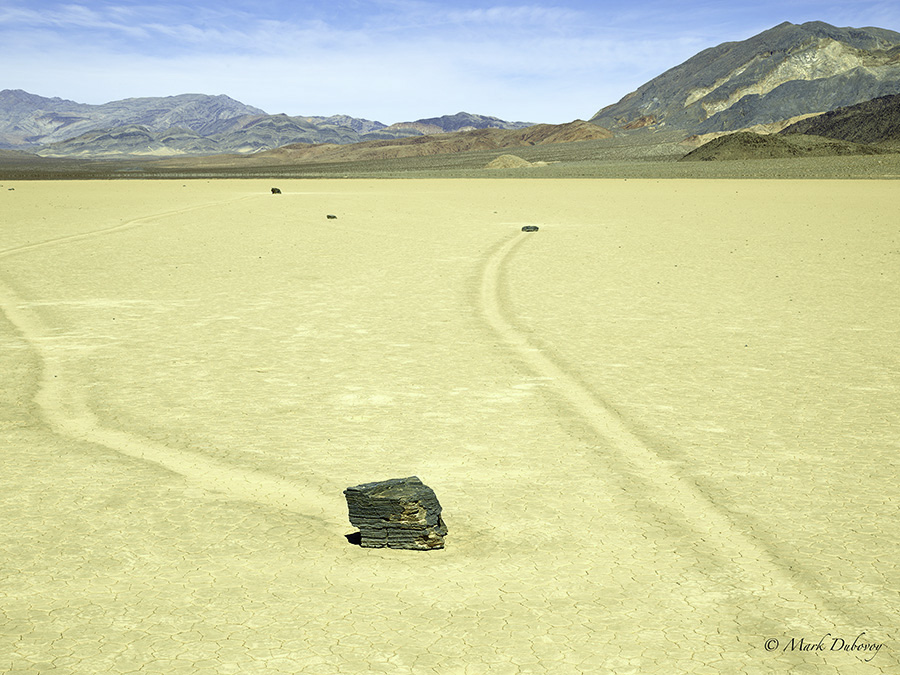
The Race Track, Death Valley
CAMBO WRS 1600 with 90 mm Rodenstock APO Digaron lens
The CAMBO WRS 1600
I call myself a “recovering View Camera addict”. I love View Cameras and I love the images one can capture with them. In many ways they are still the most powerful photographic capture instruments available.
In the days of film, I basically had no choice. In order to obtain the quality I craved and demanded, I had to use a view camera. I spent many years using an 8×10 and a 4×5. It took a lot of time and practice to learn how to properly use camera movements (tilt, swing, rise, fall and shift) and carrying the equipment was a real pain, but all of it was well worth the effort.
In the digital age, one can still use view cameras and I did use a Linhof MC 679 for a while, but I found that I could do everything I needed for my style of landscape photography with a technical camera instead. Although camera movements can be somewhat restricted with a technical camera, it does have the advantage of much smaller size and weight, and no bellows. The problem with bellows is that they are usually fragile and they tend to flap in the wind, which can affect the sharpness and resolution of the image. I have also seen the bellows in view cameras (while the photographer is in the process of changing lenses) act like kites in windy conditions causing accidents such as broken cameras and tripods.
I used ALPA technical cameras for a number of years, but more recently I have settled on the CAMBO technical cameras as my preferred choice.
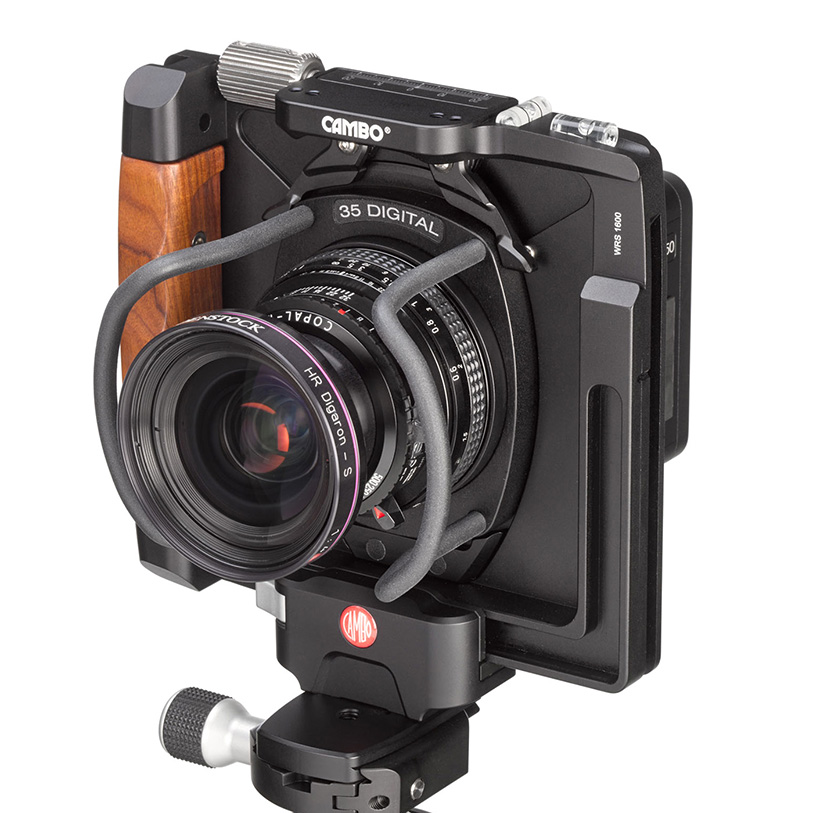
CAMBO WRS 1600 Camera
There are a number of reasons for this choice. In general, the CAMBO cameras are quite a bit smaller and lighter than the equivalent ALPA cameras. In terms of quality and precision of construction, as far as I can tell, the CAMBO cameras seem to be even better than the ALPA cameras, and that is saying a lot.
The thing that really clinches it for me is the way CAMBO has designed the camera movements. Extensive rise, fall and shift are implemented in the camera body itself with beautiful knurled knobs. There are markings on the body, there are scales for these movements and there are detents at key places. It all works very nicely. An ALPA with equivalent rise/fall and shift is much bigger, much heavier, much more expensive and the movements are not as easy to use. Other cameras like an ARCA Swiss are also much bigger, heavier and more cumbersome to use.
The most unique feature of the CAMBO cameras is that tilt and shift are in the lens mount itself. One can order lenses mounted on lens panels with or without this feature. Importantly, tilt and shift are performed at the nodal point, so the image does not move up, down or sideways when one performs these movements. As far as I know, this is unique to CAMBO and works much better than all other technical cameras. It is worth noting that other technical cameras allow either tilt or swing, but not both simultaneously like the CAMBO.
Note the two silver round knobs in the picture below. They control tilt and swing respectively. Also, notice the large knurled knob on the upper left. Two such knobs control rise/fall and left/right shift in the body. Finally, note that the lenses are mounted by CAMBO upside down from the conventional way. This makes the cable release hang straight down which is ergonomically better.
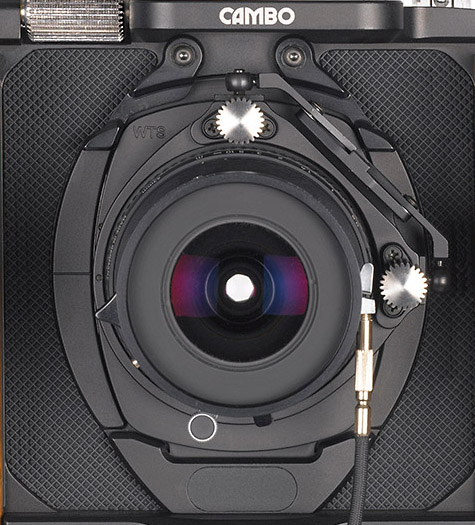
CAMBO lens mount showing tilt and swing controls.
By the way, I no longer use a cable release. I use the electronic shutter with the PhaseOne back which can be controlled wirelessly from my iPhone. I use the iPhone only if the precise time of the exposure is critical, Otherwise, I set the PhaseOne back to a shutter delay of a few seconds and I tap the shutter release button on the back screen to make the exposure.
A unique feature of the WRS-1600 is its ability to rotate the full camera/lens/back assembly in the tripod mount between landscape and protrait mode within seconds, without removing any part and still keeping the optical center in the same position. This is done by releasing a lever and sliding the camera on a built in rail to the corner, rotating it and sliding it back to the center. It’s very quick and easy to do. See pictures below:
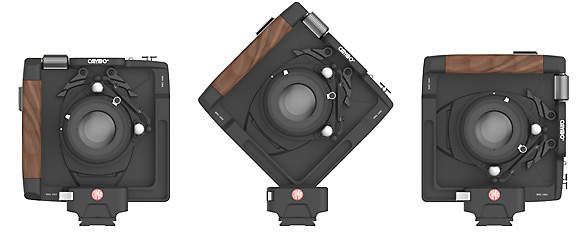
WRS-1600-Rotation
As far as I know, CAMBO is the only company that offers technical cameras that are very small and light and allow the user to have simultaneous rise/fall, left/right shift, tilt and swing.
Add to this the unique ability to rotate the WRS 1600 from landscape to portrait mode and I think I have said enough for the reader to realize why the CAMBO WRS 1600 is my current technical camera of choice.
A Few Words About Technique
For the images in this article, I used tilt in every image. This allowed me to obtain the depth of field I needed, while using the lens at its optimum aperture.
For instance, the main image at the beginning of this article was shot with a 150 mm lens and required quite a bit of tilt and some swing to make sure everything was in focus without having to close the lens diaphragm down to a small aperture. This allowed me to avoid diffraction in order to preserve sharpness and resolution. The resolution of the original file is stunning, and everything is in perfect focus.
Another example of an image that required several movements is this image of Half Dome:
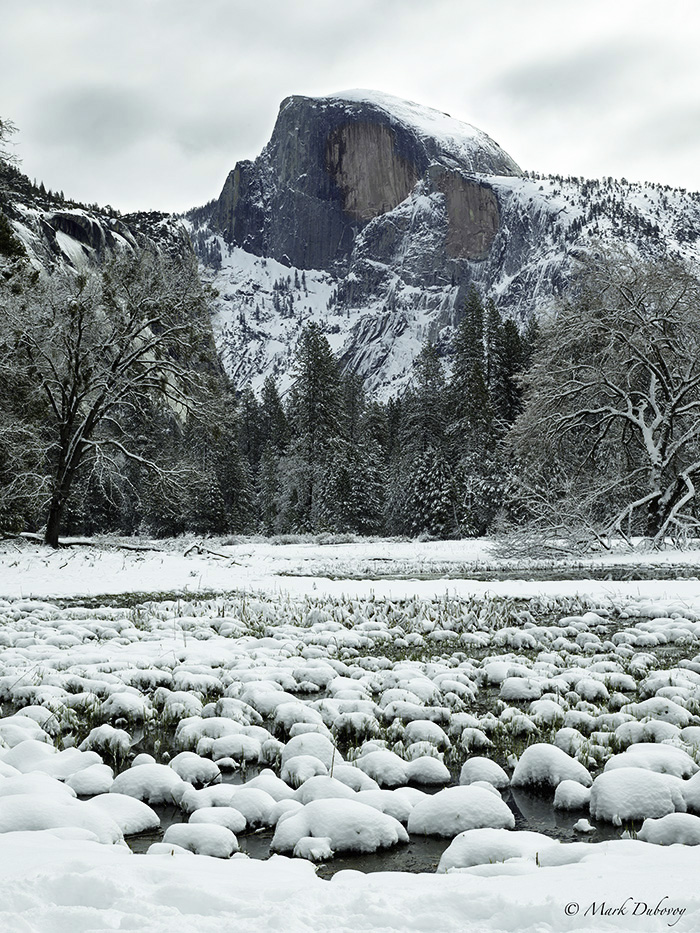
Half Dome and Puffy Rocks
CAMBO WRS 1600 with 50mm Rodenstock APO Digaron lens
The snow covered rocks in the foreground were very close to the camera. To get the entire image in perfect focus given the different angles, positions and distances of key objects, as well as preserving the proper perspective of Half Dome, required rise, tilt and a slight amount of shift.
Because of things such as wind and moving water, most of the images in this article could not have been captured with an SLR. Focus stacking would simply not have worked or required hours of tedious editing later. The job needed to be done with a single exposure.
All the images were taken using the electronic shutter feature in the PhaseOne IQ 3 100 back. I love this feature of the PhaseOne back. It allows me to use the camera with no cables of any kind and to capture images with zero shutter vibration and very tight shutter speed accuracy.
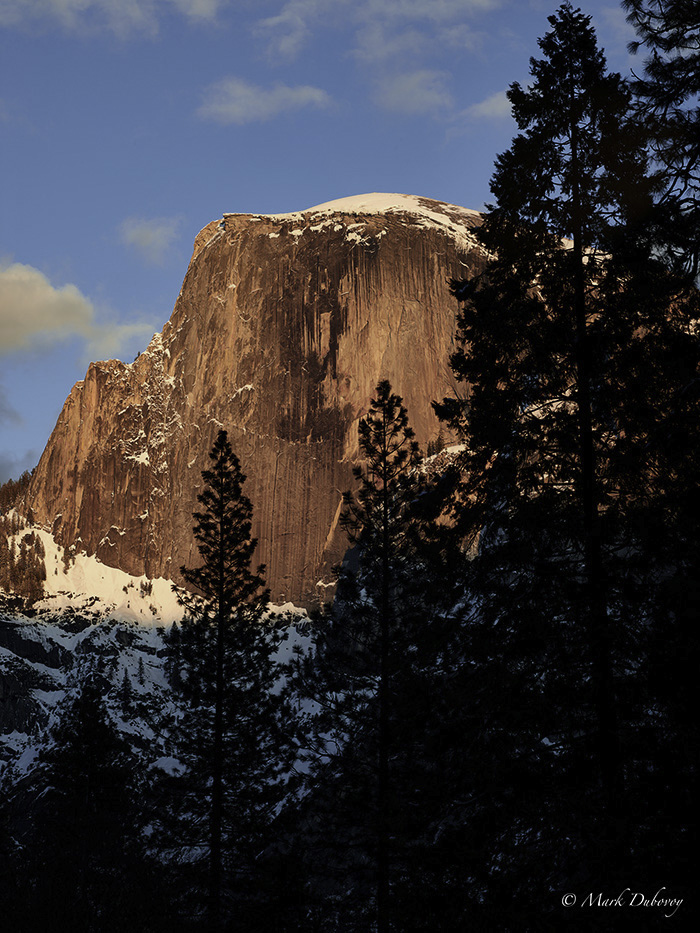
Half Dome
CAMBO WRS 1600 with Schneider 150 mm APO Digital lens
Conclusion
I learned a valuable lesson with this exercise. The lesson is never to compromise. One should always use the best tool for the job. I keep learning this lesson over and over again. My advice to you is that regardless of circumstances, always take the equipment that is most adequate to obtain the best possible images.
Looking back at this trip, I had some adverse circumstances::
1. Tough weather (it was 13 below Fahrenheit with 45 MPH winds for a couple of days in Yosemite).
2. Short times to set up and shoot, while being with non-photographers who were ready to move on quite quickly.
3. An inability to shoot at certain times of day such as sunrise because I had to be considerate and polite to my company.
In spite of these adverse circumstances, choosing the CAMBO/PhaseOne system was definitely the right decision.
As mentioned above, I cannot describe in words the joy of using a technical camera to capture beautiful landscape photographs. I only hope that my internal joy combined with the awesome feelings that this type of landscape inspires come through in my images.


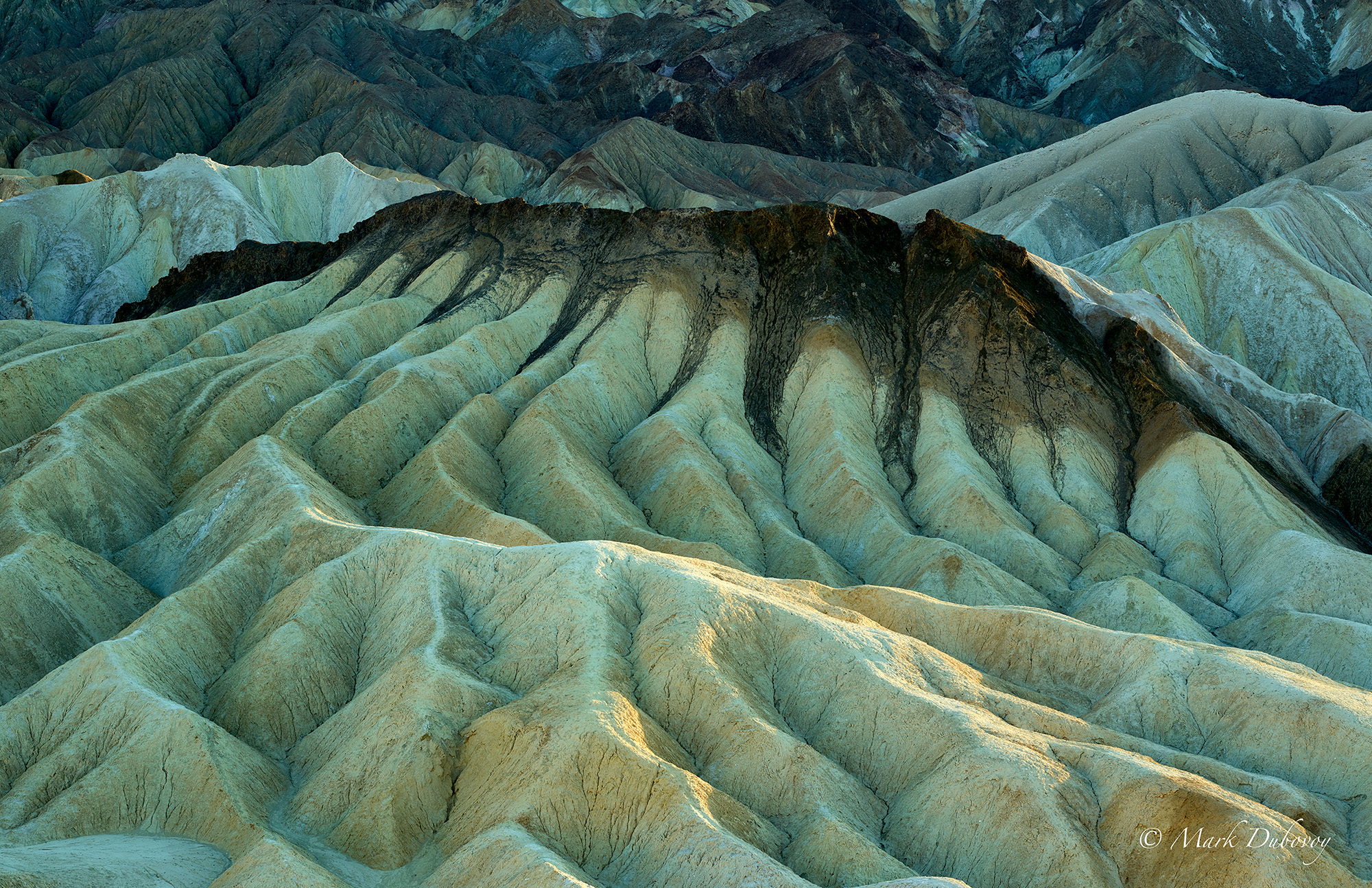



Your Thoughts